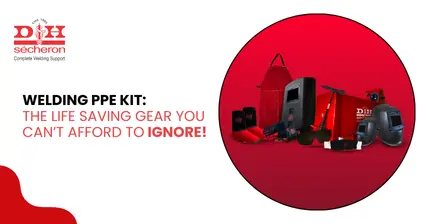
Welding cast iron rods can be quite challenging, but it's a skill worth mastering. It is a versatile material that is used in an array of tasks, from complex machinery to strong, durable pipes. Using the right cast iron welding rod with the correct techniques is crucial in order to create reliable and strong welds.
In this blog, tips will be explored that can be effective while working with cast iron welding using different methods like TIG welding, MIG welding, and Flux Cored Arc Welding.
Tip 1: Choose the Right Welding Rod Depending on the Project
There are a variety of cast iron rods available. Each of them is designed for a specific purpose. Hence, choosing the right one for a project can be an important decision. Understanding the qualities of different rods can help in picking the right welding rod. For example, nickel-based rods are preferred because of their compatibility with cast iron. This provides good weld strength and resistance to cracking.
Tip 2: Preheat the Cast Iron Surface
This is a crucial and powerful step! It reduces thermal shock, which is quite important when working with cast iron. It provides a smoother arc and reduces the risks of cracking down. When the base material is heated to around 150 degrees Celsius, it allows the welding electrodes to penetrate better while using TIG welding and MIG welding.
Tip 3: Use Proper Welding Techniques
The technique has a big impact on the strength of cast iron welds. Each method, be it TIG welding, MIG welding, or Flux-Cored Arc Welding, has its unique advantages. For instance,
-
TIG welding is ideal for more complex work like thin sections that require precision.
-
MIG welding can speed up the process for larger pieces.
-
Flux Cored Arc Welding is best suited for outdoor projects where wind can disrupt shielding gas.
It is important to change the method as per the project’s necessity.
Tip 4: Control Cooling to Prevent Cracking
The correct speed of cooling can also have a huge impact on weld strength and durability. Swift cooling can lead to cracks in cast iron welds. To diverge from this outcome, it is advisable to consider slower cooling techniques. For example, covering the weld area with insulation or using a post-weld heat treatment.
Tip 5: Post-Weld Heat Treatment
Post-weld heat treatments can reduce stress from the welded area. This ensures that welds are sturdy. This step is especially useful when using flux-cored arc welding and MIG welding. By taking this extra step of care, the longevity of cast iron components can be extended.
Whatever the project is- from making repairs to fabricating new components, these strategies can help you with all of it! By following the five tips mentioned in this blog you can improve your welding skills, handle cast iron rods more efficiently and also rely and enjoy the outcomes of your projects. Happy welding!
11 May 2025 | Welding
An In-Depth Exploration of Low-Alloy Steel: Your Comprehensive Guide
11 May 2025 | Welding
Nagpur - Bori - Tuljapur Road MSH-3 in Yavatmal District (Maharashtra)
11 May 2025 | Welding
Guidelines to Understand Gas Welding: Applications, Advantages & Disadvantages
11 May 2025 | Welding
3 Tips for Finding the Best Mild Steel Electrode for Your Application
11 May 2025 | Welding
How to Select the Right Welding Filler Wires for Stainless Steel Welding?
11 May 2025 | Welding
Building the Narendra Modi Stadium with Norma V and Autotherme-1 Electrodes
11 May 2025 | Welding
Low Alloy Steel Welding in a (PEB) Pre Engineered Building Structure
11 May 2025 | Welding
Welding Rods: Different Types and Tips for Properly Storing and Handling
11 May 2025 | Welding
Tips for Flawless Welds with Stainless Steel Electrodes: Pros and Cons
11 May 2025 | Welding
Exploring Applications and Benefits of Stainless Steel Welding Electrodes
11 May 2025 | Welding
Welding Basics: Joining Metals with Heat and Pressure - A Beginners Guide
11 May 2025 | Welding
Distinguishing Low-Alloy Steel from High-Alloy Steel: Understanding the Variations
11 May 2025 | Welding
Hard Facing Wire - Understanding the Process and Achieving Optimal Result
11 May 2025 | Welding
Exploring the Advantages of Stainless Steel Electrodes in Welding Applications
11 May 2025 | Welding
Weathering Steel vs. Traditional Steel: A Comparative Analysis of Performance
11 May 2025 | Welding
Choosing the Right Welding Rod: Why 6013 Electrodes Might Be Your Ideal Option
11 May 2025 | Welding
Why 7018 Electrodes Are Preferred for High-Strength Welds in Pipeline Construction
11 May 2025 | Welding
Filler Wire vs. Stainless Steel Filler Wire: Understanding the Key Differences
11 May 2025 | Welding
Exploring the Impact of Filler Material on Welding Quality and Durability
11 May 2025 | Welding
Choosing the Right Cast Iron Electrode for Different Welding Projects
11 May 2025 | Welding
Top Advantages of Cast Iron Electrodes for Industrial Welding Applications
11 May 2025 | Welding
Key Benefits and Challenges of Using TIG Welding in Industrial Projects
11 May 2025 | Welding
5 Reasons Why 7018 Electrode is the Gold Standard for Welding Professionals
11 May 2025 | Welding
Top 5 Advantages of Flux Cored Arc Welding for Heavy-Duty Applications.png)
11 May 2025 | Welding
Lotherme-601: A Game-Changer for Restoring Shoulder Pins in Heavy Machinery
11 May 2025 | Welding
How D&H Sécheron Helped Repair a Rotary Kiln’s Cooler Section with LoTherme 352
11 May 2025 | Welding
Piston Repair for Mining Industry: Cost-Effective Solutions with LoTherme 468.webp)






.jpg)








































.jpg)
.jpg)

.jpg)

.jpg)





.jpg)
.jpg)
.jpg)



.webp)
.jpg)
.jpg)
.webp)
.jpg)






















.png)



.webp)

.webp)
.webp)



